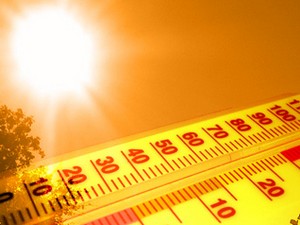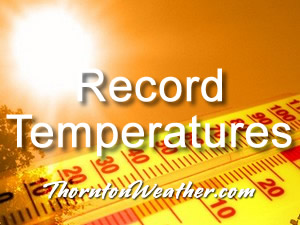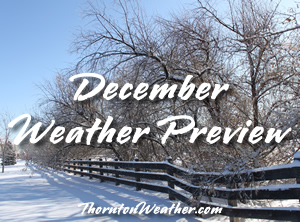 As the sun sets on 2012 and the new year dawns, we look back on the past 12 months and can see it for what it was: unusually dry and warm. While we were spared monster blizzards or much severe weather, there were still noteworthy weather events.
As the sun sets on 2012 and the new year dawns, we look back on the past 12 months and can see it for what it was: unusually dry and warm. While we were spared monster blizzards or much severe weather, there were still noteworthy weather events.
In terms of temperatures, Denver recorded an overall average of 53.8 degrees as recorded at Denver International Airport. This was 3.4 degrees above average and put 2012 in the history books as the third warmest year in Denver history. Here in Thornton we were, as usual, a bit cooler with an annual average temperature of 52.9 degrees.
The National Weather Service reported 73 days with temperatures at or above 90 degrees which far exceeds the average of 40 such days we normally see annually. Here in Thornton we too saw more than average with 62 days of 90 degree or hotter temperatures.
The late spring and early summer proved to be record setting in terms of heat. The month of June set a record high temperature average and July was the hottest month in Denver history. Two days, June 25th and 26th broke daily high temperature records and tied Denver’s all-time high temperature of 105 degrees.
On the opposite end of the thermometer, Denver officially recorded 132 days with temperatures at or below freezing. Here in Thornton we recorded two more with 134 days. On average the Mile High City records 157 days of freezing temperatures.
While the year was unusually warm, it was also extraordinarily dry. A mere 10.11 inches of precipitation was recorded in Denver’s rain bucket at DIA, 4.19 inches below normal. Here in Thornton we were even drier as we recorded 9.61 inches of precipitation in 2012. While extremely dry, neither measurement was low enough to make the list of top 15 driest years.
Total snowfall for the calendar year ended up at 38.5 inches at DIA and 35.1 inches in Thornton. Both locations fell well short of the Denver annual average snowfall of 53.5 inches. Denver’s snowfall was enough to keep it off the list of top 15 least snowiest years. However Thornton’s measurement would have made it the 13th least snowiest on Denver’s list.
Snowfall started out reasonably strong thanks to a healthy snowfall total in February. However while March is on average our snowiest month, that did not hold true in 2012. A mere 0.03 inch of precipitation was recorded setting the stage for the balance of a dry year.
Combined, June, July and August recorded only 1.81 inches of precipitation at DIA. This was an astonishing 4.02 inches below average for that period. Thornton fared only slightly better over the period with 2.34 inches.
While September brought above normal precipitation, the final three months of 2012 returned us to drier than normal conditions.
Extreme weather events were not particularly common in 2012. There was a distinct lack of heavy snow events and even spring’s severe weather season was relatively tame.
However, the hot summer temperatures and tinder dry conditions did lead to a deadly and destructive wildfire season.
The High Park Fire in June quickly became the second largest wildfire in Colorado history. That blaze was soon followed by the Waldo Canyon Fire west of Colorado Springs which went into the history books as the most destructive blaze in state history.
Click here for Thornton’s 2012 Climate Summary Report



From the National Weather Service:
CLIMATE REPORT
NATIONAL WEATHER SERVICE BOULDER, CO
130 AM MST TUE JAN 1 2013
...THE DENVER CO CLIMATE SUMMARY FOR THE YEAR OF 2012...
CLIMATE NORMAL PERIOD 1981 TO 2010
CLIMATE RECORD PERIOD 1872 TO 2012
WEATHER OBSERVED NORMAL DEPART LAST YEAR`S
VALUE DATE(S) VALUE FROM VALUE DATE(S)
NORMAL
................................................................
TEMPERATURE (F)
RECORD
HIGH 105 06/26/2012
06/25/2012
07/20/2005
LOW -29 01/09/1875
HIGHEST 105R 06/26 64 41 99 08/25
06/25 07/31
07/04
LOWEST -6 01/11 36 -42 -17 02/02
AVG. MAXIMUM 68.4 64.7 3.7 64.8
AVG. MINIMUM 39.3 36.3 3.0 36.4
MEAN 53.9 50.5 3.4 50.6
DAYS MAX >= 90 73 39.6 33.4 50
DAYS MAX <= 32 19 20.0 -1.0 23
DAYS MIN <= 32 132 156.9 -24.9 158
DAYS MIN <= 0 4 5.8 -1.8 12
PRECIPITATION (INCHES)
RECORD
MAXIMUM 23.31 1196
MINIMUM 7.29 2008
TOTALS 10.11 14.30 -4.19 17.31
DAILY AVG. 0.03 0.04 -0.01 0.05
DAYS >= .01 52 79.7 -27.7 80
DAYS >= .10 23 34.9 -11.9 37
DAYS >= .50 9 7.6 1.4 10
DAYS >= 1.00 1 2.3 -1.3 6
GREATEST
24 HR. TOTAL 1.63 MM 05/11 TO 05/12
10/26 TO 10/26
10/26 TO 10/26
STORM TOTAL MM 2.52
(MM/DD(HH)) MM 05/12(00) TO 05/12(00)
10/26(00) TO 10/26(00)6
10/26(00) TO 10/26(00)6
SNOWFALL (INCHES)
RECORDS
TOTAL MM 5
24 HR TOTAL MM
SNOW DEPTH MM MM
TOTALS 38.5 53.8 -15.3 46.8
LIQUID EQUIV 3.85 5.40 -1.55 4.68
SINCE 7/1 12.4 22.5 -10.1 29.5
LIQUID 7/1 1.24 2.20 -0.96 2.95
SNOWDEPTH AVG. 0 MM MM 0
DAYS >= TRACE 36 33.3 2.7 41
DAYS >= 1.0 13 16.3 -3.3 16
GREATEST
SNOW DEPTH 11 02/04 7 01/10
01/11
24 HR TOTAL 12.5 MM 10/26 TO 10/26
10/26 TO 10/26
10/26 TO 10/26
STORM TOTAL MM 8.5
(MM/DD(HH)) MM 10/26(00) TO 10/26(00)
10/26(00) TO 10/26(00)6
10/26(00) TO 10/26(00)6
DEGREE_DAYS
HEATING TOTAL 5198 6059 -861 6069
SINCE 7/1 MM 2468 MM MM
COOLING TOTAL 1236 0 1236 964
SINCE 1/1 1236 769 467 964
FREEZE DATES
RECORD
EARLIEST 09/08/1962
LATEST 06/08/2007
EARLIEST 10/07
LATEST 05/05
.......................................................
WIND (MPH)
AVERAGE WIND SPEED 10.3
RESULTANT WIND SPEED/DIRECTION 3/205
HIGHEST WIND SPEED/DIRECTION 52/240 DATE 06/02
HIGHEST GUST SPEED/DIRECTION 67/250 DATE 06/02
SKY COVER
POSSIBLE SUNSHINE (PERCENT) MM
AVERAGE SKY COVER 0.50
NUMBER OF DAYS FAIR 86
NUMBER OF DAYS PC 235
NUMBER OF DAYS CLOUDY 45
AVERAGE RH (PERCENT) 44
WEATHER CONDITIONS. NUMBER OF DAYS WITH
THUNDERSTORM 0 MIXED PRECIP 0
HEAVY RAIN 4 RAIN 12
LIGHT RAIN 45 FREEZING RAIN 0
LT FREEZING RAIN 1 HAIL 3
HEAVY SNOW 4 SNOW 15
LIGHT SNOW 37 SLEET 0
FOG 73 FOG W/VIS <= 1/4 MILE 21
HAZE 51
- INDICATES NEGATIVE NUMBERS.
R INDICATES RECORD WAS SET OR TIED.
MM INDICATES DATA IS MISSING.
T INDICATES TRACE AMOUNT.


 With the first full month of fall here, October usually brings one of the quietest weather months in the Denver area with plenty of mild, sunny days and clear, cool nights.
With the first full month of fall here, October usually brings one of the quietest weather months in the Denver area with plenty of mild, sunny days and clear, cool nights.







